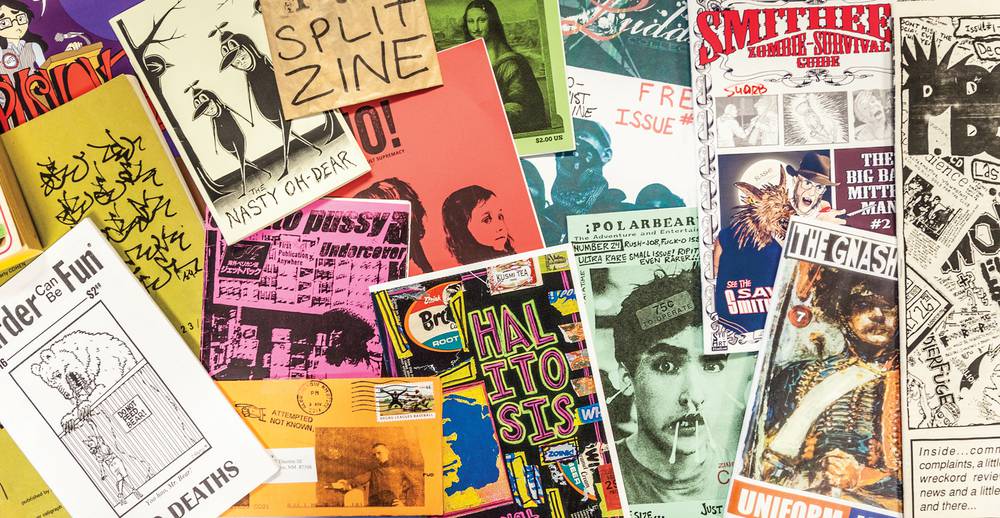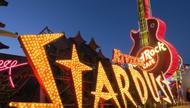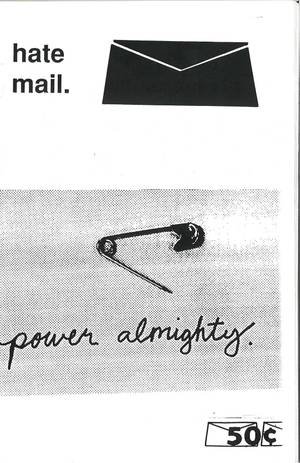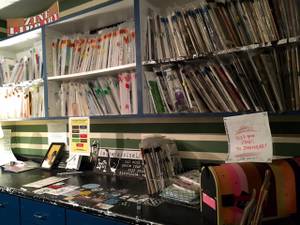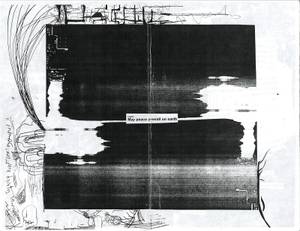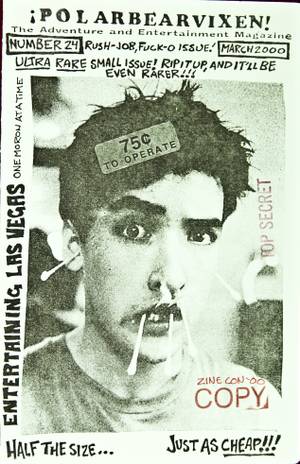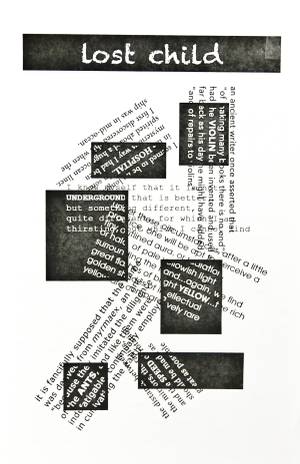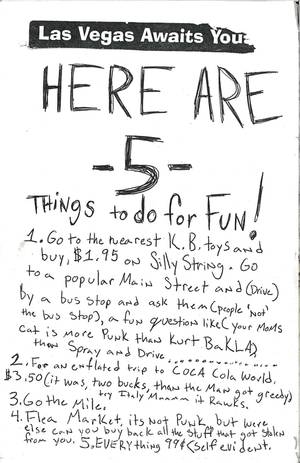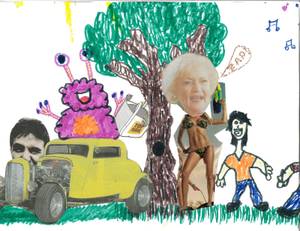Earth is in crisis. I know because a bar graph tells me we’ve reached hazardous levels of Pantera fans. Cartoons and keen words go on to confirm that toe hair and televisions are worthless human parts, and that Star Wars just ain’t punk. I learn methods of scavenging Maryland Parkway that are “only marginally theft,” that scenesters mistake pale ale for culture and that loneliness is dwarfed by solipsism, the philosophical notion that your own existence is the only real thing.
That might be the best argument for making a zine, a self-published, small-circulation, free or cheap booklet about anything. Made by a kid named Andrew in the ’90s, this one is hate mail. There’s hate for sure (groping corporate hands, goatees), but like a lot of zines, it’s driven by love—for gritty music and storytelling and Las Vegas. I know because I guessed Andrew’s last name, and I looked him up just like I did solipsism.
“It was a safe place for passionate amateurism to manifest,” Andrew Kiraly says of his zine-scribbling days fronting local punk band Boba Fett Youth. Now the boss at Nevada Public Radio’s Desert Companion magazine, he credits his first job in journalism to the stack of zines he sent an editor. While he doesn’t miss drawing boogers, “the immediate sensation of that rush of uncensored expression” pleasantly haunts him. “In a way, it was as much about the form as it was the content. … It wasn’t necessarily any kind of political impulse or definite philosophical stance. I just felt like: Man, I take such, almost physical pleasure in putting into words these cognitions that I have.” Including the wish to go back in time and make his cat’s severed leg into a keychain.
Kiraly and I owe this odd moment of connection to a library stashed in an old nurse’s station in a hallway of Emergency Arts. It’s easy to miss, even with stark-white letters spelling “INCITE” above the Zinepillar mailbox hungry for submissions. This is the Las Vegas Zine Library, “an archive of independent underground DIY publishing.”
The public collection of around 2,000 zines began as a personal one, the spoils of Jeffrey Bennington Grindley’s pilgrimages to record stores and bookshops as well as Vegas’ long-dead ZineCon. His wife Stevie Seiler says he talked forever about starting a library, so she pushed. And with support from artist Jennifer Henry and Emergency Arts operators Michael and Jennifer Cornthwaite, it materialized in 2010.
With $100, Grindley filled out his 40-zine stockpile to 100 titles on three cinder-block shelves inside the Beat Coffeehouse. Donations bumped it up to 800. Then he adopted 1,500 more from defunct indie stronghold Balcony Lights and was forced to do a little curating. I say forced because his affection for every zine on the planet is so sweetly obvious.
“It may be full of grammatical errors and misspellings, but the voice that’s there a lot of times is really, really engaging. ... Zine culture tells people: It’s worthy, it’s worthwhile, it’s enough because you did it, not because so-and-so likes it. It’s an empowering tool, especially when you’re going through adolescence. I think a lot of people find their voice through zines,” Grindley says, piling up worthiness swaddled in thin plastic sleeves.
He explains that the finely splintered zinescape grew from the fanzines of the 1930s, which grew from the reactionary writings of sci-fi hardcores in the vein of, Superman could never have walked on the sun, because it’s 5 billion degrees! So here’s my story … Publishers ran these letters and sub-fictions for a time, got inundated and cut off the outlet, so fans created their own. Fans like Stephen King and Ray Bradbury.
While fanzines are generally considered the root of the art form, Grindley says zinesters nod to everything from Martin Luther’s religious theses in the 1500s to the Dada art movement of the early 20th century to the ’50s Beat poets and ’70s punks—“anytime in history where people took to publishing themselves because the powers that be didn’t want something to get out.” And while there are a few modern examples with significant reach, ranging from underground-feminism torchbearer riot grrrl to international punk fanzine Maximum Rocknroll, most zines have print runs under 10,000 (commonly in the hundreds or less) and are likely only seen by small, specific audiences.
That’s why Grindley is so consumed with preserving these voices through the Zine Library, which moved to its bigger digs in the hallway five years ago. The bartender at Atomic Liquors and co-founder and former host of the Human Experience open-mic lets the space pretty much run itself, with signs explaining how to find things, leave things or take things from the free rack. The archive has items made as far away as Australia and as near as its own reading table. There are fanzines and journal-style perzines, photo books and political essays, academic screeds and a conspiracy digest on Kurt Cobain’s fatally undiagnosed lactose intolerance.
Actually, that last one was pinched by someone who didn’t follow the rules: Don’t eat the zines, and don’t take them home. Remember, this isn’t just about discovery.
“The people who were making zines in the ’80s and ’90s, as they’ve aged they’re like, this has to be recorded and archived,” says Grindley, adding that large-scale efforts are underway at universities and libraries in cities from Brooklyn to San Francisco to Portland, and he’s seeing a surge of creation in Las Vegas. “There have been minor flare-ups over the years, but this just seems like a super-concentration,” he says, noting that some interest might come from those fleeing the Internet’s instant, unstoppable feedback loop for old-fashioned howling into the void.
*****
Sis the lioness is licking her chops inside my head. Because “Zoo Deaths,” from San Franciscan John Marr’s Murder Can Be Fun, is an impressively researched carnival of horror Grindley thought I’d dig. Other stunners: Intrepid (Bukowski, Rexroth and friends in a 1972 special pub of the University at Buffalo), Infiltration (Canada’s buildering zine about “going places you’re not supposed to go”) and The Most Romantic Wedding in Human History (an Ohio man’s genius paste-over of a romance novel). But digging into local stuff—yellow in the Zine Library’s color-coded system—is like a Coen brothers dream sequence of Vegas.
John Cusack’s legendary face-full-o’ Q-tips stares from the grainy green cover of Polarbearvixen No. 24, the “Rush-Job, F*ck-O Issue.” It dropped in March 2000 for the final edition of ZineCon, costing 75 cents “to operate” and promising to entertain our city one moron at a time. Inside this and other issues of PBV, the rants and concert fliers suck me into the counterculture of the time, its scoundrel chroniclers breaking up meatier stuff with wrestler trading cards, a Dear Elvis column and an ad for 300 pretty girls for $1.
Smithee’s Zombie Survival Guide comes in its own biohazard bag and satisfies my need to see an undead Chihuahua. Ghetto Pussy Undercover weaves lush feminist poetry with a borrowed tale of New Jersey women fearlessly scaling telephone poles. And P.B.S. summarizes 1992: “Alternative became a raped term along with straight-edge and hardcore. People began to forget who they were so they spray-painted their idiotic names all over walls, freeway underpasses, people’s house etc. f*cken’ etc. More cultures were raped as cultureless people took apart that same culture many had hated before because they had taken their meek jobs like picking vegetables and building A-frames. The crummers of the past became those they once crummed on, to the point where they even bummed ‘the evils’ of the doers. Many awaited the Seattle Messiah to arrive in Vegas, whilst many of us kicked back and watched those same clowns go to Kenny’s to buy their Doc Martens.”
Grindley’s own Empty Letters from ’06 is a jigsaw of cinematic verse and strangeness, like a textbook excerpt on a radiation scenario in which only your hands are exposed. I wonder if he thought of that as his hands were furiously cutting and pasting this one phrase translated into many languages. It repeats and repeats, finally revealed in the center of a void: May peace prevail on Earth. A margin doodle could be nothing, or it could be a Seussian skyline spurting blood. Another looks like obscured script designed to be alllllllmost readable. Absorbing this zine is like trying to “get” a work of art. I’m never sure, and it doesn’t matter.
*****
“It was a drunken night. I had a trench coat on and I looked like Inspector Gadget. So when I found a clipboard I said, Okay, now I need to do something with this clipboard and this trench coat, ’cause I got a costume on. So I pretended I was a reporter and I was asking people questions, and I put it all down in a little zine,” Michelle Franco says of Innerviews, which Grindley discovered one night at Beauty Bar. She got friends from the arts community involved in ensuing issues, including Chris Jones, and tonight they’re sharing a cheeky fanzine devoted to Kanye West.
It’s March 22 and we’re at Cut/Paste/Copy, a quarterly Zine Library event hosted by Downtown bookstore the Writer’s Block, which just installed a consignment rack of local zines priced from $2-$4. Co-owner Scott Seeley says that piece had been missing from the shop’s literary patchwork. “It’s one of those pure art forms, where the minute somebody tells you what it is, everyone who creates it will do anything and everything to prove you wrong,” he says with a laugh. “Is it narrative? Well, it doesn’t have to be, but it can be. Is it visual? Well, it can be, but it doesn’t have to be. Is it black-and-white? Is it punk? Is it cut-and-paste? Yeah it can be, or it can be really slick. So you make them by hand? Well, not always. They can sorta be anything. ... There’s a lack of preciousness to it, which I love in art.”
That’s true of the zines on display tonight, from Pushover, Jean Marie Pilario’s autobiographical comic about the emotional dark side of Catholic school, to skate zine saucy sk8bored, which Cole Armstrong drove up from Salt Lake City to share. One that really sticks with me is On the Counter!, Chäntäl Lusk’s mashup of prose and photos she took Downtown. It’s rich with memories of childhood in the neighborhood, from Sassy Sally’s casino to the friendly mouse at her grandparents’ pink house on Third Street, and with rumination on the frequent shadow of her depression. Into the mic, she tells us she busted it out in one night. Edits are there in pen.
Imperfections, intentional and not, are part of the intimacy of reading zines.
“It can be like eavesdropping, to look into somebody’s head like that,” says Laura-Marie Taylor, a 25-year veteran of DIY publishing. From her alphabet zine Lost Child she reads “Quest,” about keeping a bag packed in high school in case the characters from Dragonlance ever came for her.
Other bits of the booklet conjure tamale superstitions, the mile she ran in a furry lavender jacket, and fonts she studied on a funeral prayer card trying to learn something important about death. Her style is spare and wonderful, and I’m not surprised to learn she has an MFA in poetry and many zines (and 30 steady pen pals) to her name. “I remember publishing how to make a Molotov cocktail and all this stuff that I thought was really edgy and really controversial when I was 13. Very embarrassing,” laughs Taylor, who today volunteers for Food Not Bombs and fills zines with her “most private things.”
She lives with schizoaffective disorder and has written frankly about its devastation and other aspects of mental illness and treatment in functionally ill, which is up to 20 issues. “The feedback has been incredible. So many people have written to me and told me that my zines made them feel less alone,” Taylor says. “I’ve been thinking, Okay, this is the last issue, since about Issue No. 3. ... I keep having more to say.”
There are countless platforms for saying something. Taylor is drawn to the particular safety and purity of making zines. “I love the fact that I don’t have to answer to anyone. I don’t have to run it by anyone. I just write exactly what I want to write, when I want to write it. ... The complete and utter freedom can let beautiful things happen that otherwise probably wouldn’t,” she says. Given the level of her craft, I ask if small errors in Lost Child, which she wrote on a typewriter, have purpose. She says they just happened, and she wouldn’t want to lose such artifacts from any zine. “The messiness is so beautiful.”
As Cut/Paste/Copy becomes a marketplace for buying, trading and talking about zines, I meet Geoff Murad, whose Luddite Collective I scored from the Zine Library’s free rack. Tonight he’s giving away Issue No. 2, featuring more anarcho-primitivist perspective handwritten on photos of protestors bucking oppression by destroying property. He says the message is to ask questions and take direct action, and the material came from notebooks filled with his own ideas and those that resonated in essays by the likes of Kevin Tucker and John Zerzan. “There’s a Timothy Leary saying, that you have to find the others,” Murad says, “so I’m just throwing a flag up and seeing what happens.”
Beyond showcasing cool work, Grindley wants this event to inspire more people to plant flags. That’s why he shares the zine-love at Atomic. Why he picks the brains of far-flung archivers and founders of innovative distros like Tempe’s Wasted Ink. And why he does monthly workshops at the library, sharing his typewriter, printer/scanner/copier, art books, scissors, markers, glue and secrets of binding and collating. He wants new zine artists to know this is easy, and old ones to be reminded there are others to find.
I ask if the Zine Library might be the truest history of Las Vegas.
“I guess it’s no more true than something that’s super-cultivated, but there’s something emotionally raw there,” Grindley says. “Maybe some of that emotion would be stripped away, and the end result, the curated result, wouldn’t quite be as honest.”
*****
The dirtiest specimen of honesty I encounter is BAKLA, both in terms of salad-tossing references and crusty, coffee-stained pages. For me, Karl Bakla’s ’90s-era fanzine represents an archetype—the righteously indignant, offensively funny antidote to the mainstream and even the “punk mainstream.” The emotion struck by the bird-flipping toddler on the cover carries, as Bakla dares the reader to have a problem with a Gandhi photo illustrating an aside about skinheads.
“I almost get off more when people don’t like it. I always remember just being a kid, being alienated, and then I’d have these friends who were like, ‘Man, wouldn’t it be cool for everyone to like your band?’ I’m like, ‘No, f*ck these people.’ I don’t want to make anything that they like. I want them to think it sucks because that’s just validation for me,” Bakla says.
His art and opinions now live mostly on his blog, People Against Goodness and Normalcy, and he’s going after bigger evil than some girl’s Cowboy Junkies tape. But he still has friends in Chile and New Zealand because of zines, and he still collects them, figuring he’s donated a couple hundred to the Zine Library over the years.
His wife Bethany says they work the archive into date-nights Downtown, and she gets a kick out of finding throwback work by friends or titles by Karl that they don’t even have. Zines were part of—and vividly document—the adolescence of her generation in Vegas, “when there were shows every night out in the desert or at Elks Lodge, and the same handful of kids from every high school would show up and those were your friends, ’cause you got picked on all week at school by the jocks but you knew on Friday night you’d read some zines and go to a punk show and see like-minded people.”
I mention the notion of a zine resurgence tied to newbies turning away from social media, and she muses that it might just be everyone who grew up in the ’90s getting nostalgic. After all, she and Karl met at Kinko’s, over a photocopy of his brother’s ass.
Maybe I’ll find that image somewhere on the shelves, tucked between the Alliance for the Libertarian Left’s newsletter and the 2010 kickoff of the library’s Zinebriated series.
That zine was born of a wall of paper erected at the Beat. The city slowly tattooed it, with one-liners, simplistic paintings, heavy math and a collage involving John Stamos’ disembodied, eyeless head joyriding on the fender of a hot rod. It’s absurd and moving, an uncensored, unyielding expression of humanness. It makes me think of a Bukowski poem I read in the Zine Library’s rare copy of Intrepid:
these typewriter ribbons skinned from our brains,
we sing a chorus from hell to every creature born
alive;
we fight with a poem
which is only something made out of paper
and us.
Cut/Paste/Copy June 23, 6-9 p.m. The Writer's Block, 1020 Fremont St., 702-550-6399.
